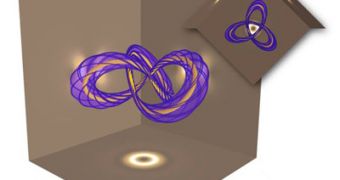Light aficionados are on fire these days. Not long ago, a bunch of brainiacs managed to create light molecules not all that different from the stuff that lightsabers in Star Wars are made of. Now, a group of physicists say that light can be tied into knots.
In a paper published in a recent issue of the journal Physical Review Letters, the researchers detail that they concluded that light can be turned into knots after finding a new set of solutions to a range of equations rolled out by Scottish physicist James Clerk Maxwell back in the 1960s.
This physicist's decades-old equations basically describe how electric and magnetic fields form and transform. 'Cause, you know, extreme makeovers aren't just for celebrity wannabes.
Since light is an electromagnetic phenomenon, said equations can also be used to document the behavior of light.
“They are everything you need to know about light and everything you need to know about the interaction of light with matter,” University of Chicago physicist William Irvine said, as cited by Scientific American.
Thus, it appears that a set of solutions to the Scottish physicists' equations stand for beams of light with a knotted structure.
When looking at these structures with the naked eye, nobody would be able to figure out that something was off, the same source details. However, the electromagnetic field lines inside them would be knotted.
“What they’ve done is shown a new sort of way that those fields can behave. No one had worked out the details or even quite suggested the possibility that the laws of nature allow for electromagnetic fields to take these shapes,” researcher Mark Dennis with the University of Bristol in England commented on these findings.
As explained on Physics World, such light knots could be created in laboratories with the help of laser beams. Once obtained, the knots could serve to trap atoms, or be fired into plasmas or quantum fluids, forcing them to assume similar structures.

 14 DAY TRIAL //
14 DAY TRIAL //